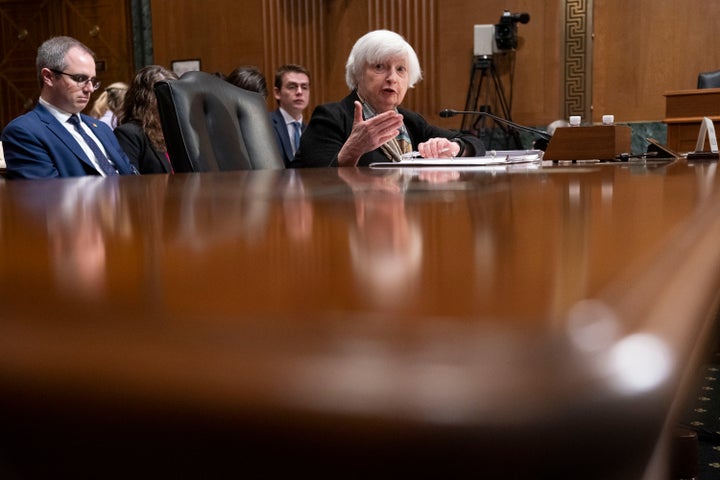Last week’s internet-enabled run on Silicon Valley Bank could give a boost to lawmakers wanting to revive a Great Depression-era law that kept the banking system safe, if somewhat dull, for more than six decades.
The idea of reviving the most important parts of the law, named Glass-Steagall after its congressional sponsors, was not even on the radar before the unexpected failure of the $209 billion Silicon Valley Bank.
But in an example of how much SVB’s fall has made some in Washington question their priors, Treasury Secretary Janet Yellen was asked about reviving Glass-Steagall Thursday at a Senate committee hearing and she didn’t shoot the idea down immediately.
“I think there will be plenty of time [when] it will be appropriate to look at what happened and consider whether or not regulatory or supervisory changes are necessary. I look forward to working with you when discussing what happened and what response is appropriate,” Yellen told Sen. Maria Cantwell (D-Wash.).
“But for now, I would like to see confidence restored in the soundness of America,” she said.
“I think there will be plenty of time [when] it will be appropriate to look at what happened and consider whether or not regulatory or supervisory changes are necessary.”
- Treasury Secretary Janet Yellen
Glass-Steagall was passed in 1933 as a response to the banking crisis caused by the Great Depression. It set up the Federal Deposit Insurance Corporation, which guarantees bank deposits up to $250,000 per bank per account. But Silicon Valley Bank depositors were guaranteed their money above the $250,000 limit in law once the bank was identified by regulators as important to the entire banking system.
Glass-Steagall is, however, mainly known for separating out commercial banking — checking accounts, CDs, personal and small business loans offered by Main Street banks — from investment banking, where well-known Wall Street bank companies trade stocks, bonds and other securities, underwrite corporate initial public offerings of stock and finance complex mergers and acquisitions.
In 1999, a Republican Congress and President Bill Clinton repealed the most important part of the law that had kept banks from offering securities or selling insurance in addition to banking. The change came after years of heavy lobbying by the financial services industry and in part as a reaction to marketplace changes and the march of technology, which was seen as making one-stop shopping for banking, securities and insurance easier.

Reviving Glass-Steagall has come up before, after the early 2000s accounting scandals including Enron and WorldCom and after the 2008 financial crisis, but it never gained much traction.
‘Capital Formation’
On Thursday, Cantwell, whose state includes the tech-heavy Seattle area that’s home to Microsoft, wondered if Glass-Steagall would have stopped SVB from failing. She also said she wasn’t sure if the current system was the best way to preserve access to capital.
“I want great access to capital formation. I don’t want to see banking that understands startups go away,” she said. As for the current system, though, she said. “I’m not sure that’s the way we get access to capital. Or at least we didn’t have a system that protected us.”
Sen. Ron Wyden (D-Ore.), chairman of the Senate Finance Committee, chimed in to say “I happen to share Sen. Cantwell’s views with respect to this.”
Reinstating Glass-Steagall, or some version of it, would require a vast overhaul of the banking system and probably make the consumer experience of buying financial services more complicated. It would also set advocates against one of the toughest, well-financed industry lobbying efforts in Washington.
Also, as Yellen pointed out to Cantwell, Silicon Valley was not an investment bank and thus not doing the sort of business commingling Cantwell worried about.
But the speed at which SVB fell clearly unsettled lawmakers, leaving some defending their votes on a separate bank dereg bill in 2018, blaming the bank itself and wondering what changes to make. Sen. Mark Warner (D-Va.), who made his fortune in the telecom industry, said that when Washington Mutual, a savings and loan, failed in 2008, it took 10 days for depositors to withdraw $16 billion.
“I’m not sure what regulatory system, anywhere, no matter how much capital and how many stress tests, would have protected any institution from a $42 billion bank run in a single day. That literally, at that point, was 25 cents on the dollar of every dollar that was deposited,” he said.
“I’m not sure what regulatory system, anywhere, no matter how much capital and how many stress tests, would have protected any institution from a $42 billion bank run in a single day.”
- Sen. Mark Warner (D-Va.)
The concerns are not necessarily unique to Democrats, either. Sen. Josh Hawley (R-Mo.), a high-profile conservative, told HuffPost Wednesday Glass-Steagall ought to be revisited.
“We used to separate commercial banks and investment banks and, you know, the FDIC only oversaw and the guarantee was only for commercial banks,” he said. “I think we need to bring that rule back.”
Hawley said he worried about a further concentration in the financial services industry because of how SVB was handled.
“We’re going to have three banks in this country. I think that’s terrible, terrible, terrible.”
Arthur Delaney contributed to this story.
